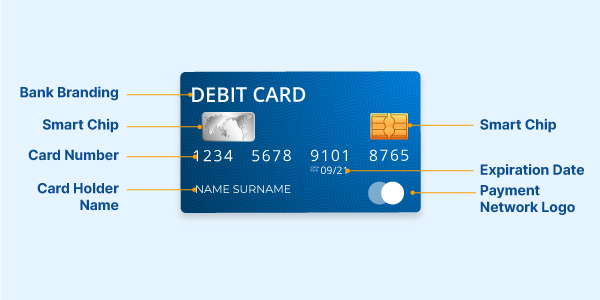Debit cards have become an irreplaceable part of our lives. Not only do they eliminate the need for us to carry cash everywhere, we can now make payments and withdraw money as needed, safely and efficiently.
Debit cards store a wealth of information, and each component tells a different story. Have you ever wondered what each of the terms and parts of a debit card refers to? Do you know what the 16-digit number in the front means or the 3-digit number at the back?
In this blog, let us decode the anatomy of a debit card.
Suggested Read: What is a Debit card

Here are the components of a debit card and what it means -
The first part that stands out is the 16-digit number on the front of your card. This is your Debit card Number.
This unique number identifies your card and comprises two main parts.
The first part (digits 1 to 6) is the Issuer Identification Number or the Bank Identification Number. Depending on whether the issuer is MasterCard or Visa, these digits will vary.
The next set of digits (7 to 15) is related to your bank account number. But in no way does it reveal your bank account number or other sensitive details.
The last digit is usually referred to as the checksum digit and this indicates if the debit card is valid or not.
The debit card will have the logo of its issuing bank on the front side of the card along with the logo of the payment network such as Visa, MasterCard, etc.
A crucial piece of information that your debit card depicts is the date of issuance as well as the expiry date of the card.
Customers usually get a call from their card provider a few months before the expiry date and a new card is issued.
EMV stands for Europay, MasterCard, and Visa. This chip exists to prevent fraudulent transactions and is for protective purposes.
Lastly, the front part of the card will also contain the name of the cardholder. Sometimes it is printed, other times it is embossed into the card.

Known as card verification value, this three-digit number is present next to the signature strip. Customers will have to enter this number every time they wish to make a transaction.
Suggested Read: What is CVV in a Debit card?
The signature strip on the back of the card is an area coated with gray or white material and can hold ink. Card users are asked to sign on this as the card will not be valid until they do. Doing so can prevent unauthorized usage of the card.
Have you ever wondered how ATM and card machines are able to ‘read’ your card and process information from it?
This is possible thanks to the magnetic strip present on the back of your card. This strip has embedded information that is used to process transactions.
A debit card will have the issuing bank’s contact details such as the customer card number or the web address.
Certain cards also have a QR code. This code, once scanned, may provide a link to the bank’s mobile application or to the website.
Customers should note that each bank’s debit card will vary slightly. Certain cards such as the ones issued by ICICI also contain a grid with different letters and numbers. This is used for additional verification during transactions.
A debit card comes with a plethora of advantages. Not only does this product make transactions easier, but it also allows customers the convenience of not having to carry cash.
It is important to understand all the information a debit card contains. Customers will need to know terms such as CVV, expiry date, and card number not only to conduct transactions but also to become informed individuals.
Debit Card Related Articles
Disclaimer
The starting interest rate depends on factors such as credit history, financial obligations, specific lender's criteria and Terms and conditions. Moneyview is a digital lending platform; all loans are evaluated and disbursed by our lending partners, who are registered as Non-Banking Financial Companies or Banks with the Reserve Bank of India.
This article is for informational purposes only and does not constitute financial or legal advice. Always consult with your financial advisor for specific guidance.
Was this information useful?